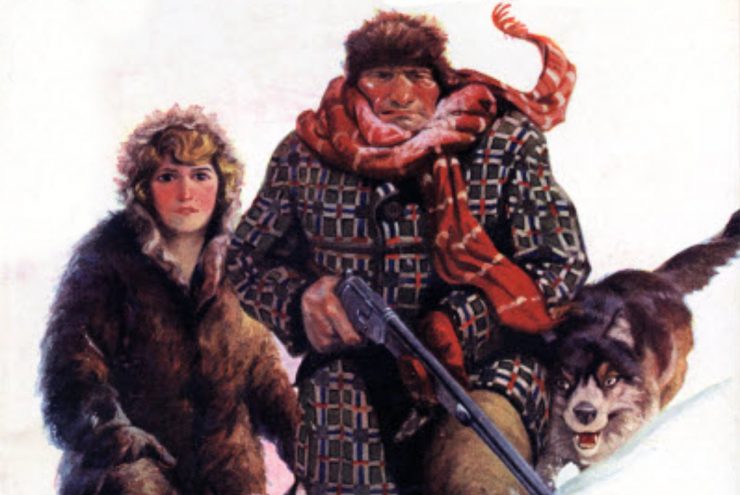Fifty years ago, there were no organized gatherings specifically geared toward pulp fiction and the magazines in which it appeared. That all changed when Ed Kessell, Earl Kussman, and Nils Hardin founded Pulpcon in 1972. This year we salute the fiftieth anniversary of that first pulp con — the convention now called PulpFest.
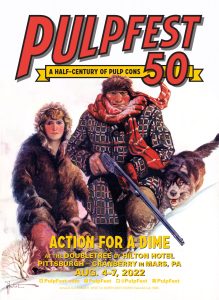 I suppose it’s all Don Hutchison’s fault.
I suppose it’s all Don Hutchison’s fault.
Several of us had gathered at the lobby of a downtown Toronto hotel that was hosting a comic con in late 1989. That’s when I met Don.
He began talking about Pulpcon. I had never heard of it, but my interest was piqued.
At Bakka — a popular science fiction book store in Toronto — they always had Canadian editions of Weird Tales on their display racks. I didn’t buy them because they were Canadian editions with crummy cover art, compared to the US editions. But damn . . . I should’ve bought ’em back then!
And all those Lancer Conan paperbacks by Robert E. Howard, the Bantam Doc Savages, and Ballantine and Ace Edgar Rice Burroughs paperbacks. I always noticed on the publication pages their pulp origins.
I’d bought pulps going back to my early teens when my father would drive us down to Columbus, Ohio to visit an aging relative who lived there. We’d always stop at a comic store on Broad Street where I’d picked up a few science fiction bedsheets. I still have them.
In any case, Don inspired me to attend my first Pulpcon in 1990. It was in Wayne, New Jersey. Some have taken to calling it, “The Pulpcon from Hell!”
Don and I drove down. We took a few wrong turns in New Jersey . . . and I thought downtown Buffalo in the sixties was rough! But we eventually arrived at Pulpcon 19 and, wow, what a convention!
The guest list was sure notable — Shirley Steeger, Jim Steranko, John Fleming Gould, Julie Schwartz, Edd Cartier, and others!
Great piles of pulps stacked on dealer tables and lots of friendly dealers. Beautiful folks, some still here but many sadly gone.
On being introduced to Sheldon Jaffrey by Don, he asked me “so now you’re also hooked?”
Don and I shared a room at William Paterson University where the convention took place. The university residences were the absolute WORST accommodations, featuring water-borne air conditioning (legionnaires disease anyone?) that forced us to shove paper into the overhead vents to keep the room (and our newly purchased pulps) dry. Then there was the mystery food in the cafeteria. We have yet to figure out the contents. But the hamburgers would have made great hockey pucks. Soylent Green for dessert?
Despite all that, we still had fun.
Besides, Don won the Lamont Award at Pulpcon 19.
So, yeah, I was hooked. I’ve been attending ever since. I’m still a newbie, compared to other pulp con attendees. I also think I met another newbie from Allentown, Pennsylvania by the name of Mike Chomko at that long-ago New Jersey Pulpcon.
When I paid my admission dues at Pulpcon 19, a lanky, bearded character, going by the name of Rusty, greeted me. He handed me a sheet of yellow paper with details on both sides about the convention. Having attended science fiction cons — including a Toronto Worldcon — I was familiar with program books outlining events, panels, guests of honor, dealer ads, researched articles, and so on. And here I get a piece of paper. But that was ok. Learning my way around the convention was a storyline straight out of a 1930s Adventure.
But I was still thinking about a chapbook or convention publication for Pulpcon. I raised the subject with a few people I met there, including a mustachioed journalist from Oklahoma named John Wooley. Bob Sampson — a true font of pulp knowledge — was also interested. As were Nick Carr, Will Murray, and several others.
Back I went to Rusty and made my pitch. He was concerned about costs, but I suppose he trusted this enthusiastic new pulp fan and asked me to forward to him a more complete proposal and articles.
I contacted those who’d expressed interest in the project and added to the participants the late, great stipple art professional, Frank Hamilton. He drafted a wrap-around cover.
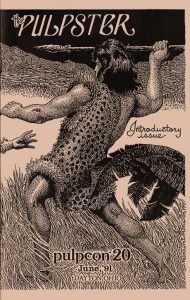 And so, The Pulpster was born. And it’s still around, a mature thirty years old. Many thanks to Bill Lampkin for keeping it alive!
And so, The Pulpster was born. And it’s still around, a mature thirty years old. Many thanks to Bill Lampkin for keeping it alive!
Why PulpFest? Why not? It’s an enjoyable convention, featuring great people to socialize with, great pulps for sale (whether I can afford them all or not), and currently, a great venue. No need to shove paper into the overhead vents at the DoubleTree!
We hope you’ll join us to celebrate “A Half-Century of Pulp Cons” at PulpFest 50. It will take place from August 4 – 7 at the DoubleTree by Hilton Hotel Pittsburgh – Cranberry in Mars, PA. You can become a member of the convention by clicking the Registration button on our website. If you need lodging, you can also book a room on our site.
A resident of Ontario, Tony Davis edited the first 21 issues of The Pulpster and continues to be a regular contributor to the magazine. He won the Lamont Award in 1999 for his many contributions to the pulp community. He’ll be one of our panelists on Thursday evening, August 4, as we celebrate “A Half-Century of Pulp Cons” at PulpFest 50.
Given Tony’s Canadian roots, our featured image is a postcard adapted by PulpFest advertising director William Lampkin from George H. Wert’s cover for the July 22, 1926 North•West Stories, published by Fiction House. In addition to painting many covers, Wert was one of the top pen & ink artists for the western pulp magazines. We’ve also reproduced Franklyn E. Hamilton’s front cover art for The Pulpster #1, published in 1991 for Pulpcon 20.
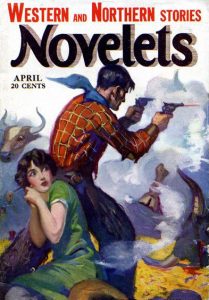 After Action Stories, North•West Stories had the longest run of any other Fiction House pulp magazine. Debuting in late 1923 as Novelets, it billed itself as “A Magazine of Action.” The title promised “Five Complete Action Novels” and initially offered adventure, western, sea, detective, and northern fiction. By the end of its first year, it was still offering, “The thrills of five complete novels in one magazine” or “Ten dollars’ worth of novel reading for twenty cents!”
After Action Stories, North•West Stories had the longest run of any other Fiction House pulp magazine. Debuting in late 1923 as Novelets, it billed itself as “A Magazine of Action.” The title promised “Five Complete Action Novels” and initially offered adventure, western, sea, detective, and northern fiction. By the end of its first year, it was still offering, “The thrills of five complete novels in one magazine” or “Ten dollars’ worth of novel reading for twenty cents!”
Things would change with the April 1925 issue of Novelets. Emblazoned above the magazine’s title were the words, “Western and Northern Stories.” The five so-called “baby novels” were gone, replaced by a single novelette, the first half of a two-part serial, and seven short stories. The change would be extended further with its May 1925 number as the pulp was retitled North•West Stories. The renamed magazine would prove so popular that by the start of 1926 it was appearing twice each month. It would maintain this schedule into late 1928.
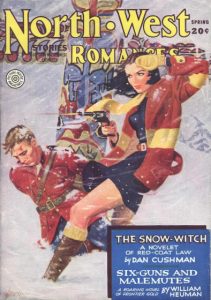 In 1932, publication of North•West Stories was suspended, along with most other Fiction House magazines. When North•West Stories returned in 1936, it was a quarterly. Perhaps in a bid to grow its female readership, the magazine was retitled North•West Romances, beginning with its Fall 1937 number. Afterward, all of its fiction was set in the Far North. Its final issue was dated Spring 1953.
In 1932, publication of North•West Stories was suspended, along with most other Fiction House magazines. When North•West Stories returned in 1936, it was a quarterly. Perhaps in a bid to grow its female readership, the magazine was retitled North•West Romances, beginning with its Fall 1937 number. Afterward, all of its fiction was set in the Far North. Its final issue was dated Spring 1953.
Through its three titles — Novelets (including the April 1925 number with cover by Sidney H. Riesenberg), North•West Stories, and North•West Romances (including the Spring 1945 number with cover by George Gross) — the Fiction House pulp would run for a total of 202 issues.
Join pulpfest.com on March 28 when award-winning novelist, journalist, and editor Craig McDonald answers the question, “Why PulpFest?”

